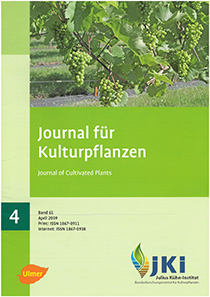Effects of Copper Contamination on Selected Indicators of the Soil Biocoenosis
Keywords:
Copper, soil, agroecosystems, indicator organismsAbstract
Numerous publications are available documenting the effects of copper based pesticides or contaminations from other copper sources on soil organisms in agriculture. Based on these investigations it may be considered that copper if applied over a long period of time harmfully affects many soil dwelling species. Due to different species dependent sensitivity to copper, dominance structure may be changed on copper polluted sites. Biodiversity decreases with increasing copper concentrations. Depending on the availability of mechanisms to detoxify, species may adapt to enhanced copper concentrations in soil. In general the herewith required input of energy seems to be high. In addition to copper content in soil other farming factors affecting the supply of minerals or regulating soil moisture may influence abundance, biomass and species diversity of soil organisms.
Micro-organisms may react in different ways; in general bacteria are more sensitive than fungi. Significant effects on short term respiration are observed at 50 mg Cu/kg soil. Mycorrhizal fungi adapted to heavy metal pollutions in soil may result in higher copper contents in the plant shoot relative to root concentrations. Generally arbuscular mycorrhiza (AM) colonization did not prevent plant metal concentrations far above normal values. On the other hand, AM also did not increase metal uptake to an alarming extent. Bacteria exposed to high levels of heavy metal concentrations may accumulate high concentrations being harmful to bacterivorous organisms, e. g. nematodes.
A comprehensive field survey including 52 vineyard and hop cultivation sites in Baden-Württemberg revealed a high site specific relationship of effects on the abundance of three copper-susceptible endogeic earthworm species as indicators of impairment of soil in its function as a habitat for soil biota. Critical concentrations derived from selected vineyards and hop fields abandoned 10 years before and 26 reference sites resulted in a threshold level of 33 mg total copper /kg soil. A field survey on the effects to the collembola community resulted in an effective concentration of 200 mg total copper/kg soil on the population level. In this study biodiversity linearly decreased with increasing copper concentration.
In recent studies using a probabilistic approach (species sensitivity distribution, SSD) critical concentrations are derived expecting harmful long term effects on representatives of the soil fauna at a level of 55 mg total copper /kg soil (41,25 kg Cu/ha). For comparison: Vineyard soils at the Mosel and Saar river having been under cultivation for a long time revealed total contents of more than 100 mg Cu/kg soil in 98% of all sites, and may end at top levels of up to 2880 mg/kg in the 0-20 cm upper soil layer. In addition data received with avoidance tests using the standard earthworm species Eisenia fetida (Annelidae) and free living species indicating a concentration of 56 mg Cu/kg soil at which earthworms try to escape from the soil substrate. An ongoing 3-year field study in charge of the European Copper Task Force showed as a preliminary result that the abundance of earthworms (mainly epigeic species) on two grassland sites was reduced at application rates of 40 kg Cu/ha (53 mg Cu/kg soil calculated on the basis of a 5 cm soil layer and a soil density of 1.5) following a 3 year application period. 40 kg Cu/ha is the tenfold application rate applied yearly in hop fields.
Accumulation of copper in earthworms (A. caliginosa) is not considered to happen to a relevant extent. The observed bio-concentration factor (BCF) is < 1 meaning that earthworms may successfully regulate the fate of copper in their body.
DOI: 10.5073/JfK.2009.04.04, https://doi.org/10.5073/JfK.2009.04.04








